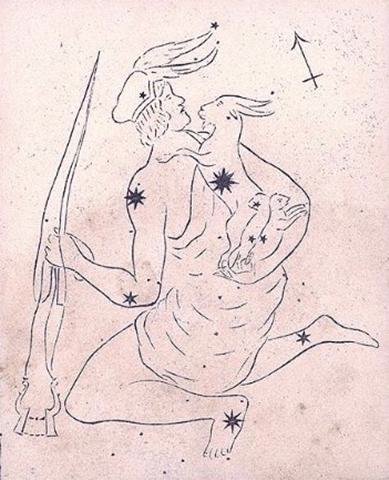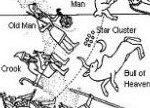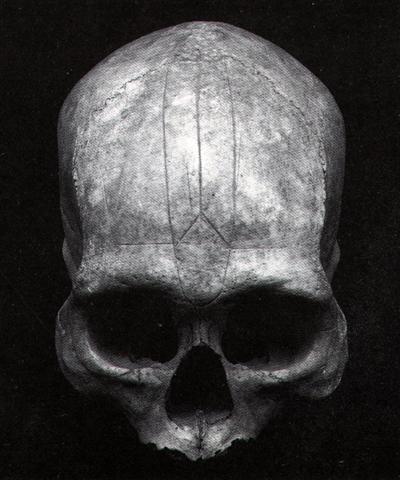The point of the upper horn of the Bull (Elnath,
β Tauri, cfr Ga1-16)
touches the left foot of the Charioteer (Auriga), indeed it here
becomes
γ Aurigae:


|
Egyptian
house |
 |
Phoenician beth |
 |
Greek
beta |
Β (β) |
|
... Like the names of
most other Greek letters, the name of beta was
adopted from the acrophonic name of the
corresponding letter in Phoenician, which was the
common Semitic word *bayt ('house'). |
|
Throwing stick? |
 |
Phoenician
gimel |
 |
Greek gamma |
Γ (γ) |
|
... In its unattested
Proto-Canaanite form, the letter
[gimel] may have been
named after a weapon that was
either a staff sling or a
throwing stick, ultimately
deriving from a Proto-Sinaitic
glyph ... Bertrand Russell
posits that the letter's form is
a conventionalized image of a
camel. The letter may be the
shape of the walking animal's
head, neck, and forelegs. Barry
B. Powell, a specialist in the
history of writing, states 'It
is hard to imagine how gimel
= 'camel' can be derived from
the picture of a camel ... The
word gimel is related to
gemul, which means
'justified repayment', or the
giving of reward and punishment.
The Swedish word gammal
means 'old' (and dry like a
stick). |
... When it was evident
that the years lay ready to burst into life, everyone took hold of
them, so that once more would start forth - once again - another
(period of) fifty-two years. Then (the two cycles) might proceed to
reach one hundred and four years. It was called 'One Age' when twice
they had made the round, when twice the times of binding the years
had come together.
Behold what was done
when the years were bound - when was reached the time when they were
to draw the new fire, when now its count was accomplished. First
they put out fires everywhere in the country round. And the statues,
hewn in either wood or stone, kept in each man's home and regarded
as gods, were all cast into the water. Also (were) these (cast away)
- the pestles and the (three) hearth stones (upon which the cooking
pots rested); and everywhere there was much sweeping - there was
sweeping very clear. Rubbish was thrown out; none lay in any of the
houses.
Changing the star's status from
β to
γ could possibly describe how at the proper time
the 'dead old gods' were thrown out from the inside of the houses.
Auriga (Crook) would then be a member of the new pantheon
while the old gods could have been represented by the Perseus (Old
Man) constellation:

... Old Man
(Perseus)
The Old Man rises in the final month of the year and is
appropriately associated with Enmesharra - an ancestral god who
resides in the underworld in the form of a ghost ...
Fishing lines could have
been a way to indicate their positions in the Milky Way river:
 |
 |
 |
 |
 |
|
Ga1-7 |
Ga1-8 |
Ga1-9 |
Ga1-10 |
|
Tabit (71.7), π▓
Orionis (71.9) |
π4 Orionis
(72.1), ο╣ Orionis (72.4), π5 Orionis (72.8) |
π╣ Orionis
(73.0), ο▓ Orionis (73.4), Hassaleh (73.6), π6 Orionis
(73.9) |
Almaaz (74.7),
Haedus I (74.8) |
|
May 31 (151) |
June 1 |
2 |
3 (520) |
|
║May 27 |
28 |
29 |
30 (150) |
|
'May 4 |
5 (125 = 148 -
23) |
6 (*46 = *73 -
27) |
7 (493) |
|
"April 20 (*30) |
21 (111 = 125 -
14) |
22 (478 = 492 -
14) |
23 |
|
Tail-6 |
ι Ophiuchi (255.3),
Grafias (255.4) |
κ Ophiuchi (256.2), ζ Arae
(256.5), ε Arae (256.8), Cujam (256.9) |
no star listed (257) |
|
Wei,
η Arae (254.3), DENEBAKRAB
(254.7) |
|
November 30
(700) |
December 1
(*255) |
2 (336 = 153 +
183) |
3 |
Hassaleh = ι
Aurigae. |
Almaaz = ε
Aurigae. |
|
║November 26 |
27 (*251) |
28 (332) |
29 |
Haedus I = ζ
Aurigae. |
Haedus II = η
Aurigae. |
|
'November 3
(673) |
4 (308 = 335 - 27) |
5 |
6 (*230) |
The blue line
between Haedus I and II represents the Milky Way. |
|
"October 20 |
21 |
22 (295 = 336 -
41) |
23 (*216) |
216 = 3 * 72 = 2
* 108 = 12 * 18 = 8 * 27. |

Tagata
with a death skull in Ga1-11 was
in rongorongo times standing
where the Milky Way (blue line
in the star chart above) ran
through the 'gateway' between
Haedus I and Haedus II. Into the
'waters' of this mighty 'river'
the images of the old gods could
have been thrown. According to
the calendar of Gregorius XIII
this was where
║May ended:
 |
 |
 |
 |
|
Ga1-11 |
Ga1-12 |
Ga1-13 |
Ga1-14 |
|
Haedus II (75.9) |
5h (76.1) |
μ Aurigae, μ Leporis (77.6) |
ĸ
Leporis (78.0), Rigel
(78.1), Flaming Star (78.2),
Capella (78.4), ο Columbae,
τ Orionis (78.8)
Thuban
|
|
ε Leporis (76.0), Cursa
(76.4), λ Eridani (76.7) |
|
June 4 |
5 |
6 (157) |
7 (524) |
|
║May 31 (151) |
║June 1 (*72) |
2 |
3 (520) |
|
'May 8 (128) |
9 (495) |
10 |
11 |
|
"April 24 (480) |
25 (115) |
26 (*36) |
27 (*403) |
|
17h (258.7) |
Mula-19 |
Nodus I (260.0), π Herculis
(260.7), Ras Algethi (260.8) |
Sarin (261.0), ο Ophiuchi
(261.4)
Alrisha
|
|
no star listed (258) |
Sabik (259.7),
η
SCORPII (259.9) |
|
December 4 |
5 (*259) |
6 (340) |
7 (707) |
|
║November
30 |
║December 1 |
2 (*256) |
3 (337) |
|
'November 7 |
8 |
9 (*233) |
10 (314) |
|
"October 24 |
25 |
26 (*219) |
27 (300) |
The glyph type hanau ('birth') has undulating
(wave-formed) legs and this could have been intended to show how life emerges from
water:
|
Egyptian
water ripples |
 |
Phoenician
mēm |
 |
Greek
mu |
Μ (μ) |
|









